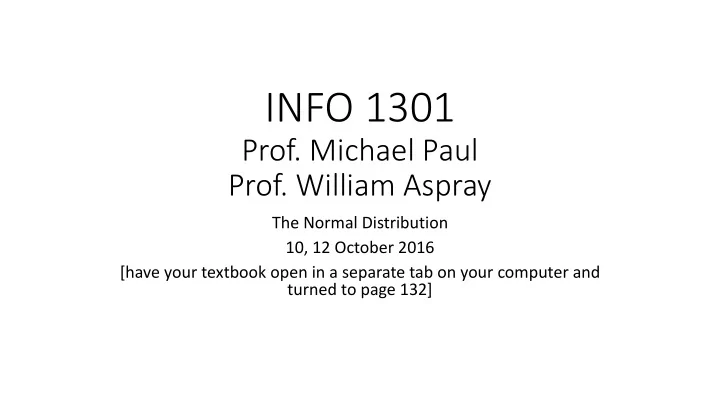

INFO ¡1301 Prof. ¡Michael ¡Paul Prof. ¡William ¡Aspray The ¡Normal ¡Distribution 10, ¡12 ¡October ¡2016 [have ¡your ¡textbook ¡open ¡in ¡a ¡separate ¡tab ¡on ¡your ¡computer ¡and ¡ turned ¡to ¡page ¡132]
Background • Scaling ¡triangles • To ¡simplify ¡we ¡will ¡work ¡only ¡with ¡right ¡triangles, ¡but ¡scaling ¡works ¡for ¡ all ¡triangles. • Unit ¡circle • trigonometric ¡table ¡– how ¡does ¡the ¡value ¡of ¡x ¡and ¡y ¡vary ¡as ¡the ¡angle ¡ with ¡vertex ¡(0,0) ¡increases • Calculating ¡lengths ¡of ¡sides ¡on ¡triangles
The ¡normal ¡distribution ¡1 • The ¡most ¡common ¡curve ¡in ¡all ¡of ¡statistics ¡and ¡in ¡all ¡of ¡the ¡ applications ¡of ¡statistics ¡to ¡science ¡and ¡engineering • Unimodal, ¡symmetric, ¡bell ¡curve • Few ¡distributions ¡are ¡perfectly ¡normal, ¡but ¡many ¡are ¡almost ¡normal ¡ and ¡many ¡applications ¡gain ¡from ¡treating ¡the ¡distribution ¡curve ¡as ¡ normal • Known ¡as ¡the ¡normal ¡distribution ¡(or ¡the ¡Gaussian ¡distribution) • First ¡mathematical ¡analysis ¡of ¡the ¡normal ¡distribution ¡by ¡Carl ¡Frederic ¡ Gauss ¡(1809) ¡– German ¡child ¡prodigy
The ¡normal ¡distribution ¡2 • The ¡normal ¡distribution ¡is ¡defined ¡by ¡the ¡mean ¡(mu, ¡written ¡as ¡ μ ) ¡and ¡ the ¡standard ¡deviation ¡(sigma, ¡written ¡as ¡ σ ) • Written ¡as ¡N( μ , ¡ σ ) ¡ • What ¡does ¡changing ¡the ¡mean ¡do? • What ¡does ¡changing ¡the ¡standard ¡deviation ¡do? • Why ¡don’t ¡we ¡have ¡to ¡worry ¡about ¡the ¡height?
The ¡normal ¡distribution ¡3 • Any ¡point ¡x ¡on ¡the ¡standard ¡deviation ¡can ¡be ¡identified ¡by ¡the ¡ number ¡of ¡standard ¡deviations ¡it ¡is ¡away ¡from ¡the ¡mean • This ¡is ¡called ¡the ¡Z-‑score ¡of ¡x, ¡or ¡Z(x) • It ¡is ¡given ¡by ¡the ¡formula ¡Z(x) ¡= ¡[x ¡– μ ]/ σ • If ¡Z(x) ¡is ¡negative, ¡x ¡is ¡to ¡the ¡left ¡of ¡the ¡mean. • If ¡Z(x) ¡= ¡0, ¡x ¡is ¡the ¡mean. • If ¡Z(x) ¡is ¡positive, ¡x ¡is ¡to ¡the ¡right ¡of ¡the ¡mean. • The ¡larger ¡the ¡absolute ¡value ¡of ¡Z(x), ¡the ¡more ¡unusual ¡the ¡ observation ¡is.
The ¡normal ¡distribution ¡4 • Let’s ¡do ¡an ¡example ¡that ¡appears ¡in ¡the ¡book • The ¡normal ¡distribution ¡of ¡the ¡SAT ¡is ¡given ¡by ¡N(1500,21), ¡while ¡the ¡ normal ¡distribution ¡of ¡the ¡ACT ¡is ¡given ¡by ¡N(300,5). ¡ • Ann ¡gets ¡an ¡1800 ¡on ¡the ¡SAT, ¡while ¡Tom ¡gets ¡a ¡24 ¡on ¡the ¡ACT. ¡Which ¡ student ¡did ¡better ¡on ¡the ¡college ¡entrance ¡exam? • Hint: ¡compare ¡the ¡Z ¡scores ¡for ¡Tom ¡and ¡Ann. ¡
The ¡normal ¡distribution ¡5 • N(0,1) ¡is ¡called ¡the ¡standard ¡normal ¡distribution. • It ¡plays ¡a ¡similar ¡role ¡in ¡studying ¡the ¡statistics ¡of ¡normal ¡distributions ¡ that ¡the ¡circle ¡of ¡radius ¡1 ¡centered ¡at ¡the ¡origin ¡(0,0) ¡does ¡in ¡ trigonometry. • Draw ¡N(0,1). ¡Note ¡where ¡its ¡mean ¡is ¡located. ¡Note ¡that ¡few ¡points ¡are ¡ less ¡than ¡-‑3 ¡or ¡greater ¡than ¡3 ¡in ¡this ¡distribution. • An ¡important ¡fact ¡about ¡N(0,1), ¡which ¡we ¡won’t ¡prove ¡is ¡that ¡the ¡area ¡ under ¡the ¡curve ¡= ¡1.
The ¡normal ¡distribution ¡6 • Suppose ¡we ¡cut ¡the ¡x-‑axis ¡into ¡a ¡lot ¡of ¡small ¡pieces, ¡each ¡1/100 ¡long, ¡ and ¡tried ¡to ¡figure ¡out ¡the ¡area ¡of ¡the ¡curve ¡that ¡is ¡to ¡the ¡left ¡of ¡a ¡ given ¡point ¡along ¡the ¡x-‑axis ¡called ¡x a . ¡ • As ¡x a moves ¡to ¡the ¡right, ¡the ¡area ¡increases. • What ¡happens ¡when ¡x a = ¡0 ¡? • Important ¡fact: ¡In ¡a ¡normal ¡distribution, ¡the ¡median ¡and ¡the ¡mean ¡ are ¡identical. ¡Both ¡are ¡at ¡x a = ¡0.
The ¡normal ¡distribution ¡7 • Since ¡the ¡mean ¡and ¡median ¡are ¡identical ¡on ¡a ¡normal ¡distribution, ¡on ¡ this ¡drawing ¡of ¡N(0,1), ¡the ¡point ¡x a where ¡Z=0 ¡is ¡not ¡only ¡the ¡mean; ¡it ¡ is ¡also ¡the ¡median ¡and ¡thus ¡x a is ¡at ¡the ¡50 th percentile. • [Remember ¡that ¡percentiles ¡go ¡generally ¡with ¡medians, ¡not ¡means; ¡ but ¡in ¡a ¡normal ¡distribution, ¡where ¡the ¡mean ¡= ¡the ¡median, ¡we ¡can ¡ talk ¡about ¡percentiles. • So, ¡let’s ¡go ¡back ¡to ¡Ann’s ¡score ¡on ¡the ¡SAT. ¡What ¡percentile ¡is ¡she ¡in ¡ among ¡all ¡the ¡test-‑takers ¡of ¡the ¡SAT?
The ¡normal ¡distribution ¡8 • Ann’s ¡percentile ¡would ¡be ¡hard ¡to ¡calculate, ¡though ¡we ¡could ¡eyeball ¡ the ¡graph ¡and ¡see ¡approximately ¡where ¡she ¡is. • However, ¡just ¡like ¡there ¡are ¡trigonometry ¡tables, ¡there ¡are ¡normal ¡ distribution ¡tables. ¡They ¡measure ¡the ¡area ¡under ¡the ¡curve ¡to ¡that ¡ point ¡= ¡percentile ¡(given ¡the ¡Z ¡value). • Turn ¡to ¡table ¡3.8 ¡in ¡your ¡textbook ¡(p.132) ¡[This ¡is ¡a ¡fragment ¡of ¡the ¡ full ¡table, ¡which ¡is ¡given ¡in ¡Appendix ¡B.1 ¡(p. ¡427).] • How ¡do ¡we ¡read ¡this ¡table? • What ¡happens ¡to ¡the ¡table ¡entries ¡as ¡the ¡input ¡numbers ¡increase? ¡Is ¡ this ¡what ¡we ¡should ¡expect?
The ¡normal ¡distribution ¡9 • Example: ¡Harken ¡back ¡to ¡the ¡early ¡2000s. ¡Michael ¡Paul ¡is ¡a ¡high ¡ school ¡junior ¡getting ¡ready ¡to ¡take ¡his ¡SATs ¡while ¡listening ¡to ¡50 ¡Cent ¡ and ¡the ¡Black ¡Eyed ¡Peas. ¡What ¡is ¡the ¡probability ¡that ¡his ¡SAT ¡scores ¡ on ¡the ¡test ¡will ¡be ¡greater ¡than ¡1800? ¡(Assume ¡the ¡mean ¡is ¡1500 ¡and ¡ standard ¡deviation ¡is ¡300 ¡on ¡the ¡three-‑part ¡2400 ¡point ¡exam.) ¡ • Do ¡you ¡think ¡his ¡scores ¡would ¡have ¡been ¡higher ¡if ¡he ¡had ¡been ¡ listening ¡to ¡Beethoven ¡and ¡Schubert ¡instead?
The ¡normal ¡distribution ¡10 • Identify ¡the ¡percentage ¡of ¡events ¡that ¡fall ¡within ¡1, ¡2, ¡and ¡3 ¡standard ¡ deviations ¡of ¡the ¡mean ¡in ¡a ¡normal ¡probability ¡distribution. ¡ • Use ¡these ¡approximations ¡for ¡everyday ¡rough ¡estimates
Recommend
More recommend